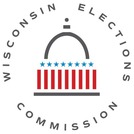
This short lesson provides students an opportunity to learn who can be a candidate for state, local and federal offices in Wisconsin.
- Subject:
- Civics and Government
- Material Type:
- Activity/Lab
- Author:
- Christopher Lese
- Date Added:
- 06/29/2022

This short lesson provides students an opportunity to learn who can be a candidate for state, local and federal offices in Wisconsin.

(Taken from website)
In this lesson, students evaluate hypothetical candidates by establishing and applying their own criteria for selecting public officials. Through a variety of activities, students assess candidates based on their qualifications, experience, campaign speeches and campaign materials. Students track campaign promises, explore voting records and evaluate the legitimacy of information resources. The role of the media, fundraising and opinion polls in the electoral process is also discussed.
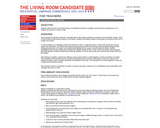
This lesson should be used to help students think critically about political ads, using historical examples. They can then use this knowledge to evaluate current examples of political ads.
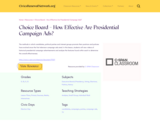
The methods in which candidates, political parties and interest groups promote their positions and policies have evolved since the first television campaign ads aired. In this lesson, students will view videos of historical presidential campaign advertisements and analyze the features found within each to determine the overall effectiveness.
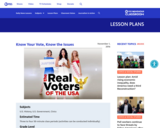
Every election year and for years after elections, there are several major issues that persistently trouble Americans. Every election year, politicians pledge that they will address these issues, and nearly every year they fall short of many peoples’ expectations. This time may be different, but it will take an educated voting population to explain to politicians exactly what they want done to address the issues. In this lesson, we begin that process by examining problems surrounding health care costs, funding higher education, and preserving social security. Then, students look at how the current presidential candidates are proposing to address these issues, and formulate a short media presentation using Flipgrid (https://info.flipgrid.com/) or some other media presentation tool to endorse one candidate.
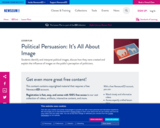
Students identify and interpret political images, discuss how they were created and explain the influence of images on the public’s perception of politicians.
This activity requires a free registration for Newseum ED educator resources.
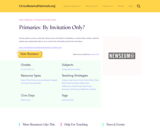
Primary season can be a wild ride. Voters narrow the field of candidates in contest after contest, while the parties use complicated rules to try to control who ultimately secures the nomination.

This unit provides an introduction to Student Voices, focusing on the question of why so few
young people vote and why there is a need for young people to learn more about the political
process, issues, and candidates.
Spanish Version
https://cdn.annenbergclassroom.org/wp-content/uploads/Campaign-Curriculum_Spanish.pdf